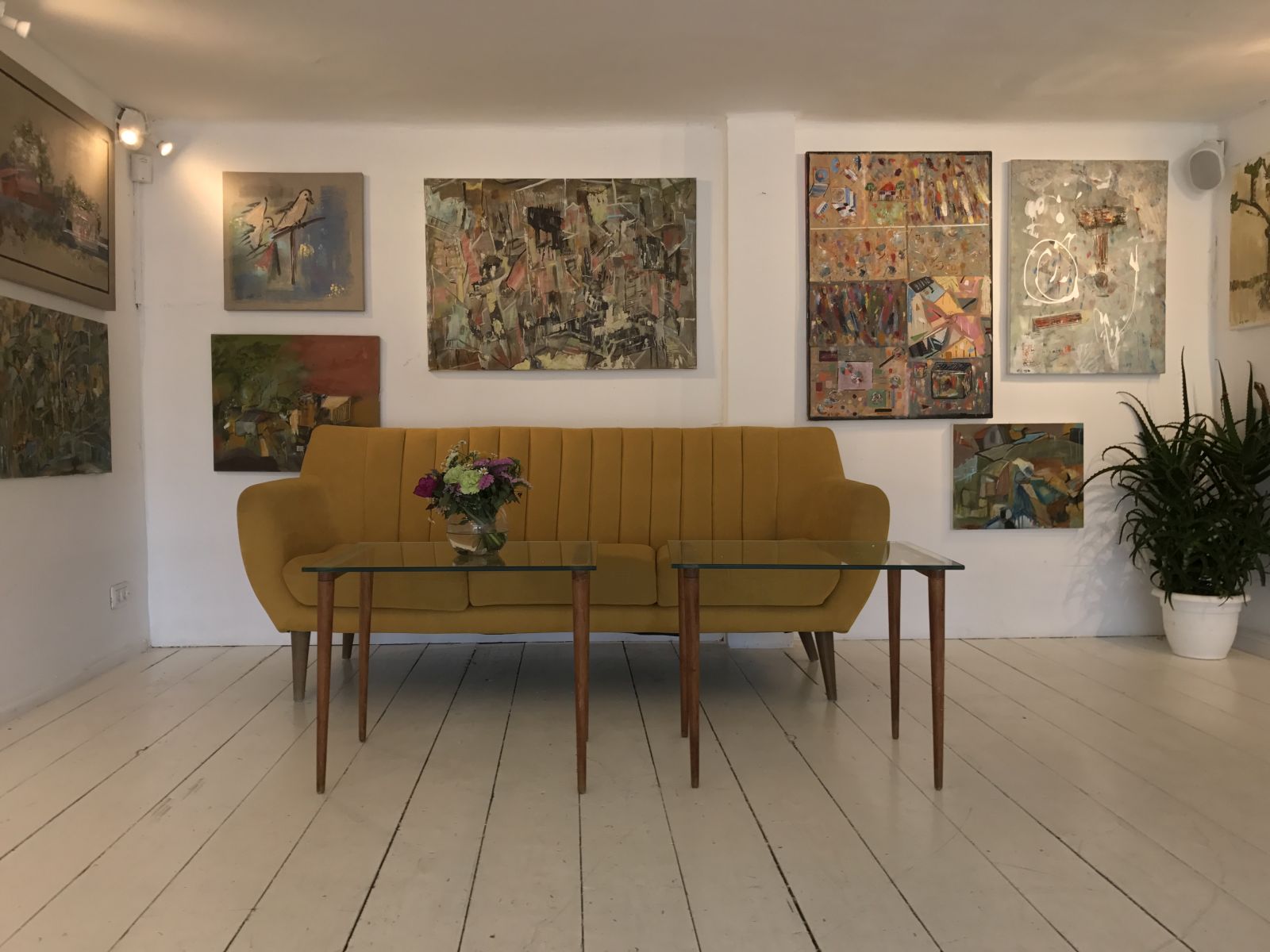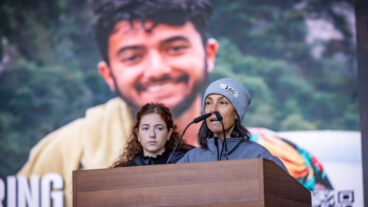It’s Thursday morning in Florentin. There are craftsmen trundling by with barrows of bedsteads and wood, old men with thick gray moustaches selling dried fruit and nuts, hipsters with black beards on bikes, and young bohemian women with piercings walking dogs — so many dogs.
The trendy cafes, vegan kiosks and tattoo parlors are already doing bustling trade. There are shops selling pet toys, and others selling sex toys. And on every wall, every billboard and corner, there is eclectic graffiti, giving the area an exciting and unique energy.
This tiny neighborhood, sandwiched between Jaffa and the center of Tel Aviv, is all about contrasts. Old and new, traditional and contemporary, rich and poor – this is a community that’s in the midst of gentrification and change.
Derelict buildings stand next to smart new apartment blocks. Expensive furniture shops jostle alongside ancient wholesale businesses with rotting signs. There are pricey art galleries on one side of a road, and dilapidated warehouses where you can fix your furniture or your car on the other.
There’s an industrial zone, a wholesale garment district, a thriving food market and a burgeoning art scene. And when day turns to night, Florentin transforms into one of the trendiest areas for pubs and clubs in Tel Aviv.

In 2014, Thrillist voted Florentin the second hippest neighborhood on earth after Williamsburg in New York. The travel website wrote: “In a city already known for its Bauhaus-style architecture, inspired street art, and 24-hour nightlife, Florentin’s the go-to spot for artists, musicians, and people who dress like artists and musicians.”
Florentin boasts other records, too; it’s got the most vegan restaurants per capita in the world, and Florentin Street has more dog owners per capita than anywhere else.
A young vibe
While there are some older families still living in Florentin, 60 percent of residents are under the age of 45, and 55% are under 35, according to Tel Aviv Deputy Mayor Asaf Zamir. As a whole, Tel Aviv is one of the youngest Western metropolises in the world.
The unique character of Florentin lies in its roots. The neighborhood was founded in the 1930s and named after David Florentin, a Greek Jew who purchased the land in 1924 for the Salonika-Palestine Investment Company.
It was originally planned as a simple and pretty neighborhood for working-class immigrants from Greece and Turkey, especially from Salonika. But as the years went on, the immigrants gradually abandoned Florentin, and like much of the rest of southern Tel Aviv, it became increasingly neglected and impoverished.

It was only in the late 1990s, when an eponymous Israeli TV drama brought attention to this rundown neighborhood, that it began gradually to revive. Students and artists were attracted to the cheap rents, large loft-style apartments and were ready to ignore the grittiness and dirt.
As they moved in, turning dingy apartments into trendy live-work spaces, so did new cafes, nightclubs, music venues and shops.
One of the most significant signs of Florentin’s revival is that a new elementary school has opened, currently serving about 150 pupils in first and second grade, and is designed for 600.
“It’s the first school we have needed in Florentin for decades,” says Zamir. “ In the last five to seven years the population has grown older. It used to be people in their 20s; now people are still living here in their 30s. They are having families and they are staying. The hipster neighborhood is settling down.”
Florentin food
Many things make Florentin unique. It has a different feel than the rest of Tel Aviv because the buildings – many of which are Bauhaus – are crammed up against each another. The sidewalks are narrow and there are virtually no green spaces. “This creates a very dense urban atmosphere,” says Zamir.
The food culture is also unusual. Levinsky Market, founded in the 1930s, is the beating culinary heart of this neighborhood, and it still sells the traditional Turkish, Greek and Romanian specialties that dominated the market when it first opened. Today, it’s a gourmand’s paradise.
“Levinsky still looks the same as it did 50 or 60 years ago,” says Aaron Gertz, a 32-year-old tour guide who lives in Florentin.

There are many great shops in the market, some of them unique. Take Yom Tov deli, for instance. The deli was founded in 1947 and named after the founder, Yom Tov, which means “good day” in English. Today the deli still sells items like hibiscus flowers stuffed with cheese, and is run by Yom Tov’s grandson and namesake. The stuffed vine leaves on sale in the shop are still rolled by the original Yom Tov, now 93.
“This is really traditional Sephardic food,” says Gertz.

In a sign of the times, Yom Tov has expanded and opened a sandwich bar and a vegan ice cream parlor nearby.
Other great places to visit in the market include the Har Sinai Nut Shop, founded more than 38 years ago; Baklava Mahrum, which sells Middle Eastern desserts and sweets; and Chaim Raphael, which sells gourmet cheeses, cured olives and meats, all prepared using traditional methods.
Florentin also abounds with trendy cafes, restaurants and bars, like Bugsy, Café Casbah, Diwan, a Bedouin café, Hoodna and Perla.

Street-art paradise
The most obvious thing that stands out in Florentin, however, is the graffiti. You can find graffiti all over Israel, but nowhere does it come to life quite so much as in Florentin, where the authorities tend to turn a blind eye. Here, street art is an active daily dialogue.
“Every day I come out there’s something new,” says Gertz, who often takes people on graffiti tours through the neighborhood. “You never know what to expect. There is so much art all over the place. ”
Some of the most common graffiti artists include Mr. Leaf, who creates tiny people out of beads; Adi Sened, an architect who creates box people; EPK who paints eggplants – everywhere; Kis-Lev, and Murielle Street Art, who frames her work with window and door frames.

There’s even vegan graffiti – you’ll see “269” stenciled all over the walls to represent cow number 269, who was released by vegans into the wild and is now happy and free, or so the story goes.
As a result of all this artistic activity on the street, it’s no surprise that a number of galleries have emerged in the last few years, including Urban Secret Gallery (formerly Street Art Gallery), Under 1000, Tiny Tiny and Meshuna.
A place where people can be themselves
The question that bothers many Florentin residents today is how the neighborhood will develop in the years ahead.
Its near neighbor, Neve Tzedek, was once as rundown as Florentin. Today, it’s one of the most expensive places to live in Tel Aviv. The houses have all been renovated, and the shops sell expensive designer brands. Does the same fate await Florentin, which is already going through a significant building boom?

Zamir is sanguine. “It will always be different,” he says. “Florentin is the only closed neighborhood in Tel Aviv that involves all four elements of urban life. It’s residential and commercial, it has a lively leisure market – with a good nightlife and lots of restaurants — but it also has a light industrial area. That creates a very interesting mélange of people, with different requirements, but it also creates urban chaos. It’s hard to clear four waste cycles a day, and as a result it can be hard to keep the area clean, and this is what kept rents low for so many years.”

The municipality does plan, however, to demolish the rundown industrial warehouses of the Volovelsky zone and replace them with buildings like 4 Florentin, a project of four nine-story apartment blocks designed by architect Ilan Pivko. With commercial space, a swimming pool, a gym and a spa, it’s hardly the kind of development that attracts young people or young families.
Though Volovelsky isn’t expected to disappear any time soon – Zamir says it could take up to 20 years – the new apartment blocks that replace it will transform the character of the neighborhood in a significant way.
I ask Gertz whether he thinks Florentin will one day become like its rich, yuppy neighbor. He looks alarmed. “I hope not,” he says. “I love it here. It’s really authentic. You never know who or what you will see. This is a place where people can really be themselves.”

















